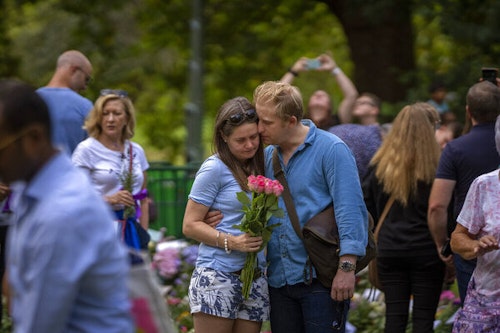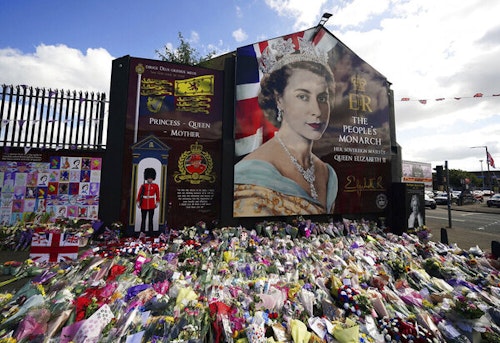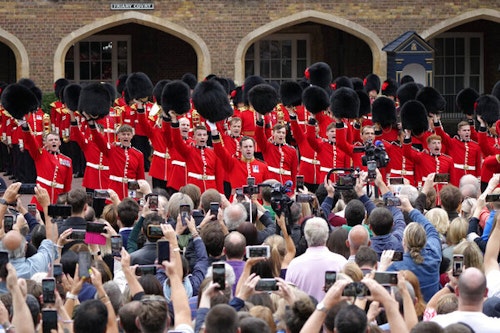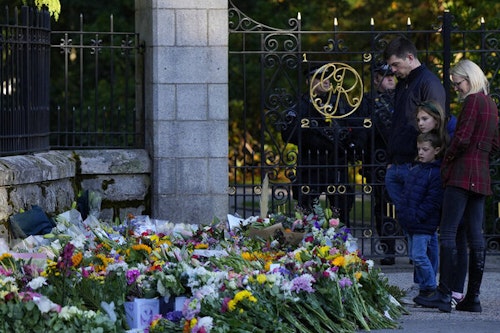The late Queen's coffin will lie in state for 24 hours at St. Giles Cathedral in Edinburgh.
The coffin of Queen Elizabeth II will lie in state at St. Giles Cathedral in Edinburgh for 24 hours, before returning to London on the Royal train, ahead of a state funeral next Monday.
Prince Charles and other members of the Royal Family are expected to arrive in the Scottish capital on Monday for the service of remembrance.
Crowds of people lined the streets of Edinburgh as the cortege carrying the Queen's coffin arrived in Sunday, making the journey by road from the Balmoral estate in the Highlands, where she past away last Thursday.
Well-wishers gathered in their tens of thousands to pay their final respects at designated viewing spots along the way in the cities of Aberdeen, Dundee and Edinburgh.
Her coffin law at rest in the Palace of Holyroodhouse overnight.
The funeral of Queen Elizabeth II is scheduled to take place on Monday, 19 September, in London, Buckingham Palace announced on Saturday evening.
The funeral service will be held at Westminster Abbey at 10 am GMT (11 am CET) and is expected to be attended by a number of world leaders. King Charles III, her son who succeeded her, has declared the day of the funeral a bank holiday in the United Kingdom.
As Britain and the world continued to mourn Queen Elizabeth this weekend, her son Charles was proclaimed King by the Accession Council in the state apartments of St James’s Palace on Saturday morning.
The historic session proclaiming Charles III as the new sovereign was followed by the reading of the Principal Proclamation from the palace's balcony, followed by fanfare and gun salutes throughout the country.
Review the weekend's events in our blog below:

 ${title}
${title}
Live ended
In summary
- Queen Elizabeth II's funeral cortege arrived in Edinburgh on Sunday afternoon after setting off from Balmoral Castle earlier in the day.
- Thousands came out to pay respects to the late sovereign along the six-hour car procession through Scotland in honour of the Queen.
- Elizabeth II's funeral will take place in London on 19 September, Buckingham Palace announced on Saturday evening.
- Charles was proclaimed King by the Accession Council in the state apartments of St James’s Palace on Saturday morning to fanfare and gun salutes throughout Britain.
- In his first address as monarch from Buckingham Palace, King Charles III said on Friday evening the Royal Family owed a "heartfelt debt" to his mother, and vowed to carry on her "lifelong service".
- Charles said his son William would succeed him as Prince of Wales, with William's wife Catherine becoming Princess of Wales.
- William declared he would provide full support to his father in an emotional goodbye to his grandmother, the Queen.
- As tributes continue to flood in from around the world for the Queen, a period of national mourning has been declared until the end of the day of the state funeral.
- King Charles III: Who is the UK's new monarch?
- From Churchill to Yeltsin and Tito to Trudeau, the Queen's extraordinary reign in pictures.
- How is Europe reacting to the death of Britain's longest-reigning monarch?
- Obituary: Queen Elizabeth II's life of service, dedication and duty
The Queen's coffin arrives in Edinburgh
The Queen's procession with the burgundy-coloured Bentley carrying her coffin has arrived in Edinburgh, the capital of Scotland, as it makes its way to the royal residence in the Palace of Holyroodhouse.
Large crowds have gathered along the path on the Royal Mile and in other parts of Edinburgh.
The Queen's coffin passes Dundee, leaves Scottish highlands
The Queen Elizabeth II's funeral cortege has passed Dundee, as thousands come out to pay honour to the British sovereign who passed away last week.
The cortege has crossed the River Tay and has left behind the Scottish highlands as it continues its journey south toward Edinburgh.

Charles III formally proclaimed King in the rest of the UK as country honours Elizabeth II's funeral cortege
King Charles III on Sunday was formally proclaimed the new monarch in the rest of the nations of the United Kingdom: Scotland, Wales and Northern Ireland.
It came a day after the accession ceremony in London saw him take over the throne accompanied by fanfare and gun salutes throughout the country.
In Edinburgh, crowds gathered to watch the ceremony and sing the anthem, "God Save the King".
Queen Elizabeth II’s flag-draped coffin meanwhile, was passing through the rugged Scottish countryside on a final journey from her beloved summer estate Balmoral Castle to London, with mourners quietly lining roads and some tossing flowers to honour the monarch who died after 70 years on the throne.
The hearse drove past piles of bouquets and other tributes as it led a seven-car cortege from Balmoral, where the Queen died Thursday, for a six-hour trip through Scottish towns to Holyroodhouse Palace in Edinburgh.
Charles III to visit four UK nations in his first trip as monarch
King Charles III will embark on a tour of the four nations that make up the United Kingdom -- England, Scotland, Wales and Northern Ireland -- beginning on Monday with Scotland. This is his first royal engagement since the passing of Queen Elizabeth II, titled Operation Spring Tide -- the codename for his first trip as King. He will be accompanied by the Queen Consort.
The tour is intended to lead the nations in mourning across the UK, with services held at each stop, including a vigil at St Giles' Cathedral on Monday. He will be accompanied by Liz Truss, who also recently became the country's new Prime Minister.
On Sunday, King Charles III is scheduled to meet with the Secretary General of the Commonwealth at Buckingham Palace. He will also host the High Commissioners of the countries in which he is head of state at the Palace later in the day.
Scottish leader says Elizabeth II's passing caused 'profound, deeply touching' grief
Scottish First Minister Nicola Sturgeon said the Queen's passing marks a moment of shared loss.
"The grief we have seen across the world has been profound and deeply touching. It will be especially poignant to see Her Majesty's coffin begin its journey from her Aberdeenshire home to the Palace of Holyroodhouse in Edinburgh."
Sturgeon said Her Majesty's death at Balmoral Castle means "Scotland has lost one of its most dedicated and beloved servants," she said.
"We anticipate many, many people will be keen to pay their respects."
Queen's coffin leaves Balmoral for Edinburgh, thousands gather to pay respects
Queen Elizabeth II’s flag-draped coffin left her beloved Scottish estate Balmoral Castle on Sunday as the monarch, who died after 70 years on the throne, began her last journey back to London for a state funeral.
The hearse drove past piles of flowers and other tributes as it led a seven-car cortege from Balmoral, the summer retreat where the Queen died on Thursday, for a six-hour journey through Scottish towns to Holyroodhouse Palace in Edinburgh.
The late Queen's coffin was draped in the Royal Standard for Scotland and topped with a wreath made up of flowers from the estate, including sweet peas, one of Elizabeth II's favourites.
Queen's funeral to be held on 19 September
The funeral of Queen Elizabeth II, who died Thursday in Scotland, will take place on Monday, 19 September in London, Buckingham Palace announced Saturday.
The funeral will be held at Westminster Abbey at 11 a.m. (10 a.m. GMT) and is expected to be attended by world leaders, including US President Joe Biden, French President Emmanuel Macron, European Commission President Ursula von der Leyen, and Canadian and Australian PMs Justin Trudeau and Anthony Albanese.
The Queen will be lying in state in Westminster Hall for "four clear days" from 14 September, a Palace official said. The Westminster Hall will also be closed to visitors until 19 September in preparations for the funeral.
King Charles III, her son who succeeded her, has declared 19 September a bank holiday in the United Kingdom.

Prince William pledges to support his father King Charles III in an emotional goodbye to his grandmother, the Queen
Prince William, the heir to the throne, paid a moving tribute on Saturday to his grandmother Queen Elizabeth II, and pledged to support his father, King Charles III, "in every way possible".
Hailing the Queen in a statement as "an extraordinary leader whose commitment to the country, the Realms and the Commonwealth was absolute," he also said he was sad to have lost his grandmother, to whom he was very close.
"My grandmother said that grief was the price we paid for love. All the sadness we will feel in the weeks to come will be a testament to the love we had for our amazing Queen. I will honour her memory by supporting my father, the King, in any way I can," said the eldest son of Charles III, who was on Friday awarded the title of Prince of Wales.
"While I mourn her loss, I also feel incredibly grateful," he added, noting that he had benefited from "her wisdom and comfort" for 40 years.
“She was by my side at my happiest moments. And she was by my side during the saddest days of my life.
“I knew this day would come, but it will be some time before the reality of life without Grannie will truly feel real," William said.
UK Cabinet has first audience with King Charles III
The Cabinet, led by Prime Minister Liz Truss, had an audience with King Charles after he was formally proclaimed monarch in succession to the late Queen.
The King spoke at length with Foreign Secretary James Cleverly and Defence Secretary Ben Wallace, domestic outlets reported.
The Cabinet members were presented to the King by Truss as they lined up inside the 1844 Room at Buckingham Palace.
Following the Cabinet audiences, the King spent time meeting the leaders of opposition parties, including Labour leader Keir Starmer.

Principal Proclamation read as Charles III publically declared King
The Principal Proclamation, announcing Charles III as the new British monarch was read from the St James’s Palace balcony, preceded by fanfare.
The proclamation, ending with the Coldstream Guard playing the royal anthem "God Save the King," was accompanied by gun salutes across the country at 11 am GMT (12 pm CET).
The ceremony is a part of the historic series of events proclaiming that the monarch has died and announcing the new sovereign has taken their place.
Accession Council proclaims King Charles III as the new British monarch
The Accession Council has formally appointed Charles III as the new British sovereign in a session on Saturday morning, marking one of the final steps in his taking over the crown after the passing of Elizabeth II on Thursday.
The proclamation, which was read by the clerk of the Council, was then signed by key signatories such as the Prince of Wales and the Queen Consort.
"Charles III, by the grace of God of the United Kingdom of Great Britain and Northern Ireland and of his other realms and territory, King, head of the Commonwealth, defender of the faith, to whom we do acknowledge all faith and obedience with humble affection, beseeching God by whom kings and queens do reign to bless His Majesty with long and happy years to reign over us,” the proclamation read.
The Accession Council was followed by the Privy Council held by the King, with Charles III making a series of oaths and declarations.

Accession Council to proclaim Charles III as the new sovereign begins
The Accession Council at St James’s Palace has met to proclaim Charles III as the new King.
The ceremony, which will be televised for the first time, gathered 250 officials, including all six living former prime ministers and senior church figures.
Charles' son William, who was given the title of Prince of Wales by his father on Friday, will be present.
However, Charles III will not be in attendance until he holds his first Privy Council later in the session.
The reading of the Principal Proclamation from the palace balcony is expected an hour after the Accession Council begins, followed by fanfare and gun salutes.

Australians pay their respects to the Queen, PM Albanese to travel to the UK
Throughout Australia, people have been paying their respects to Queen Elizabeth II following her death on Thursday.
Earlier on Saturday, Australian politicians and foreign diplomats laid wreaths to honour the Queen in Canberra.
Governor General David Hurley, Prime Minister Anthony Albanese and Opposition Leader Peter Dutton were joined by diplomats and other leaders at the ceremony at the Queen's Terrace in the country's parliament.
Albanese reiterated Australia's sympathies for the Royal Family and the United Kingdom.
Albanese and Hurley will be heading to the UK in the coming days.
The Crown pauses production of its latest season out of respect for Elizabeth II
“The Crown,” Netflix's acclaimed series about Queen Elizabeth II and her family, has paused production due to the monarch's passing.
A spokesperson for the award-winning series said production was paused on Friday “as a mark of respect” and will also be suspended on the day of the Queen's funeral.
The show is in production on its sixth season. Its first two seasons starred Claire Foy as the young princess Elizabeth ascending to the throne and gradually growing into her role as monarch, and seasons three and four featured Olivia Colman as a more mature Queen.
Its fifth season, with Imelda Staunton playing the Queen, will premiere in November.
What happens on Saturday and in the coming days?
Here are the main events lined up for the weekend and subsequent days, as the UK mourns Queen Elizabeth and goes through the formalities of King Charles' accession.
(Timings are all BST, +1 for CET)
— 10 a.m. — Charles meets at St. James’s Palace with senior officials known as the Accession Council and is officially proclaimed King.
— 11 a.m. — An official reads the proclamation aloud from a balcony at St. James's Palace. It is also read out in other locations across the UK.
— 1 p.m. — Parliament holds a second day of tributes to the Queen.
Subsequent days:
— The Queen’s body is moved from Balmoral Castle in the Scottish Highlands to Edinburgh, where the coffin is likely to rest at Holyrood Palace before being moved to St. Giles' Cathedral so members of the public can pay their respects.
— The coffin will be transported by train or plane to London.
— The Queen will then lie in state for several days in Parliament’s Westminster Hall, where the public will again be able to pay their respects.
— A state funeral at Westminster Abbey will be attended by leaders and dignitaries from around the world.
— The period of national mourning will end after the day of the Queen’s funeral.











